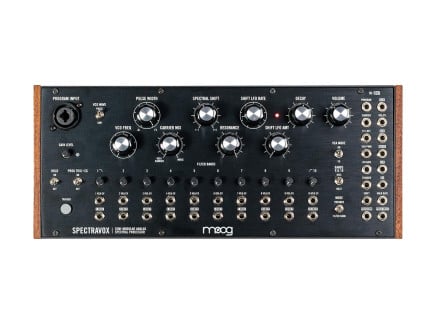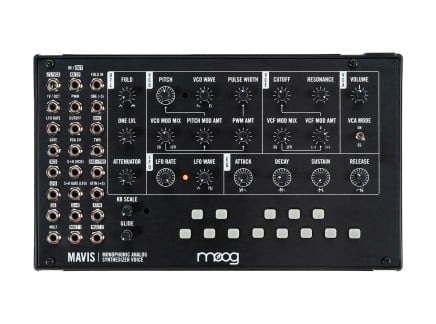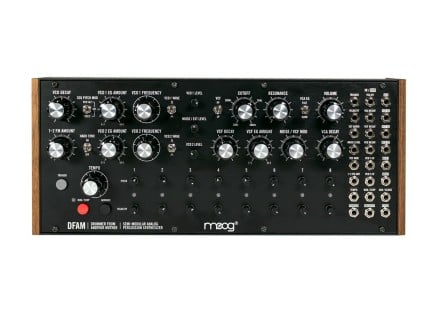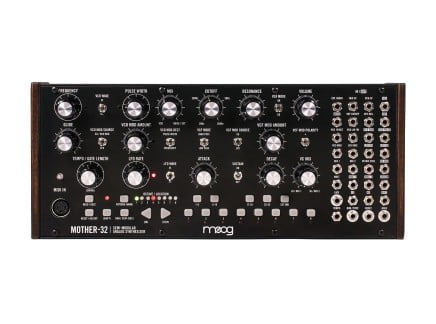Today, Moog announces a new product: Spectravox, the newest addition to their growing family of compact, self-contained, semi-modular synthesizers. Like the DFAM and Subharmonicon before it, Spectravox was originally a "workshop" instrument assembled in small numbers by participants at Moogfest. Now, it appears in a revised form—packed with more features, and ready to integrate into your modular or semi-modular setup.
That said, Spectravox is a quite different instrument from its predecessors Mother-32, DFAM, and Subharmonicon. While those instruments are all designed to be truly self-sufficient—pairing analog sound engines with integrated sequencing facilities—Spectravox is perhaps better thought of as an advanced spectral processor. While it does have internal sound generation via a single VCO and noise source, it starts to shine when either controlled from external sources or used as a processor for external sounds.
You can think of Spectravox as a combination filter bank, vocoder, and a means by which to extract a variety of control voltages from external signal sources. You can use it as an instrument—you can use it as an effect—and it can easily fit into any setup, be it based on effect processing, synthesized sound generation, studio-based reamping, and much more. Let's take a look at Spectravox's features to see how it might fit into your workflow.
Moog Spectravox Overview: Filter Bank Mode
To understand Spectravox, we first need to understand what a filter bank is. In short, a filter bank is a common synthesis tool, in which many filters (all tuned to different cutoff frequencies) are used to process a single sound. Ultimately, these filters' outputs are summed together. This gives you a way to sculpt the overall spectrum of the sound by emphasizing or de-emphasizing specific frequency ranges. You can think of this as something like a particularly dramatic or colorful equalizer. These types of tools have been part of electronic music production since its inception, when adventurous musicians co-opted the scientific test and measurement equipment used in laboratories and radio stations; later, they appeared in the earliest commercial analog modular synthesizers (including Moog's own early systems), and they continue to be valuable tools today.
We'll spare you the deeper history right now—I'd recommend checking out this excellent article by Naomi Mitchell for an idea of the history and functionality of these tools. But, for the moment, it's important to note that historically, most "filter bank" modules used for electronic music have been fixed filter banks: that is, they are filter banks in which each individual filter band is set to a specific, unchanging cutoff frequency. But...what if you could make all of those cutoff frequencies variable?
This seems to be the core question at the heart of Spectravox. While it does have all the tools one might expect from an analog synthesizer—oscillator, noise source, VCA, LFO, envelope, etc.—the star of the show is certainly its filter section, which is comprised of not one, but ten individual filters, each with independent loudness controls. In ascending order of frequency, one filter is a lowpass; eight are bandpass filters; and one is a highpass filter. While the frequency/pitch intervals between all of these filters is constant, you get a macro control (Shift) for cutoff frequency which is applied to all bands...allowing you to shift the entire bank's frequency range up and down as desired. The "shift" amount my be modulated with the internal LFO, and may even be voltage-controlled using external CV sources as well. Additionally, there is a front-panel macro resonance control that applies to all of the filter bands. This won't go quite up into self-oscillation, however, at higher values it exhibits a lovely, controlled "ringing" character, opening up huge realms of potential.
The instrument's filtering characteristics are controlled by these "shift" and resonance controls, but also by per-band level controls toward the bottom of the panel. Each band features a small trimmer knob which can be used to set that specific band's level; additionally, each of the bands features a CV input for level control, which may be attenuated via those same band level knobs. So, when paired with external control voltage sources like envelopes, LFOs, sequencers, etc., a huge range of evolving spectral effects can be achieved.
Internally, Spectravox's filter bank is fed by its own oscillator and noise source. The oscillator features saw and pulse wave shapes, selectable via front-panel switch. The pulse wave does offer manual pulse width control and PWM (although, PWM may only be achieved via patching on the right-hand patch bay, and does not offer any built-in normalled modulation). The selected oscillator shape passes to another crossfader (Carrier Mix), allowing a continuous mix between the selected oscillator tone and noise—which heads to the filter bank's audio input. The oscillators feature an extremely wide frequency range, extending downward well into LFO territory. This fact, combined with the various aspects of the filter bank itself, open up a number of sonic possibilities. For instance, only turning up a few specific filter bands and sweeping the Shift control can produce formant-like effects. Turning up the resonance and turning the oscillator into low-frequency range allows you to "ping" the filters at low rates, turning the resonant ringing of the filters into a sound source all its own. The effects range from phaser-like sweeps to water droplets, vocal-like sounds, physical modeling-esque resonator tones, and much, much more. (Try modulating the filter frequency at audio rate while "pinging" it at low frequencies—you'll get all manner of weird, noisy, FM-like tones.) If desired, you can bypass the VCO's connection to the Carrier Mix control by passing a signal into the Carrier jack on the patch bay—allowing you to process any external sound source through Spectravox's filter bank. You could use the output of your modular system, another semi-modular synth, or any relatively hot signal source—the possibilities are near endless.
After the output of the filter bank, the sound passes to a VCA, whose CV input is internally normalled to a decay-only envelope generator. This may be bypassed by turning the "VCA Mode" switch to the ON position. If using the internal envelope, it may be triggered via the front-panel Trigger button, the Trigger input on the patch bay, or using an external audio signal patched into the Program input. That said...what the heck is the Program signal input for, anyway?
Moog Spectravox Overview: Vocoder Mode
So far, we've only discussed using Spectravox in one mode: Filter Bank mode. However, the front-panel Mode switch also allows you to access a separate mode designed for using Spectravox as a Vocoder. So, quickly...what even is a vocoder, really?
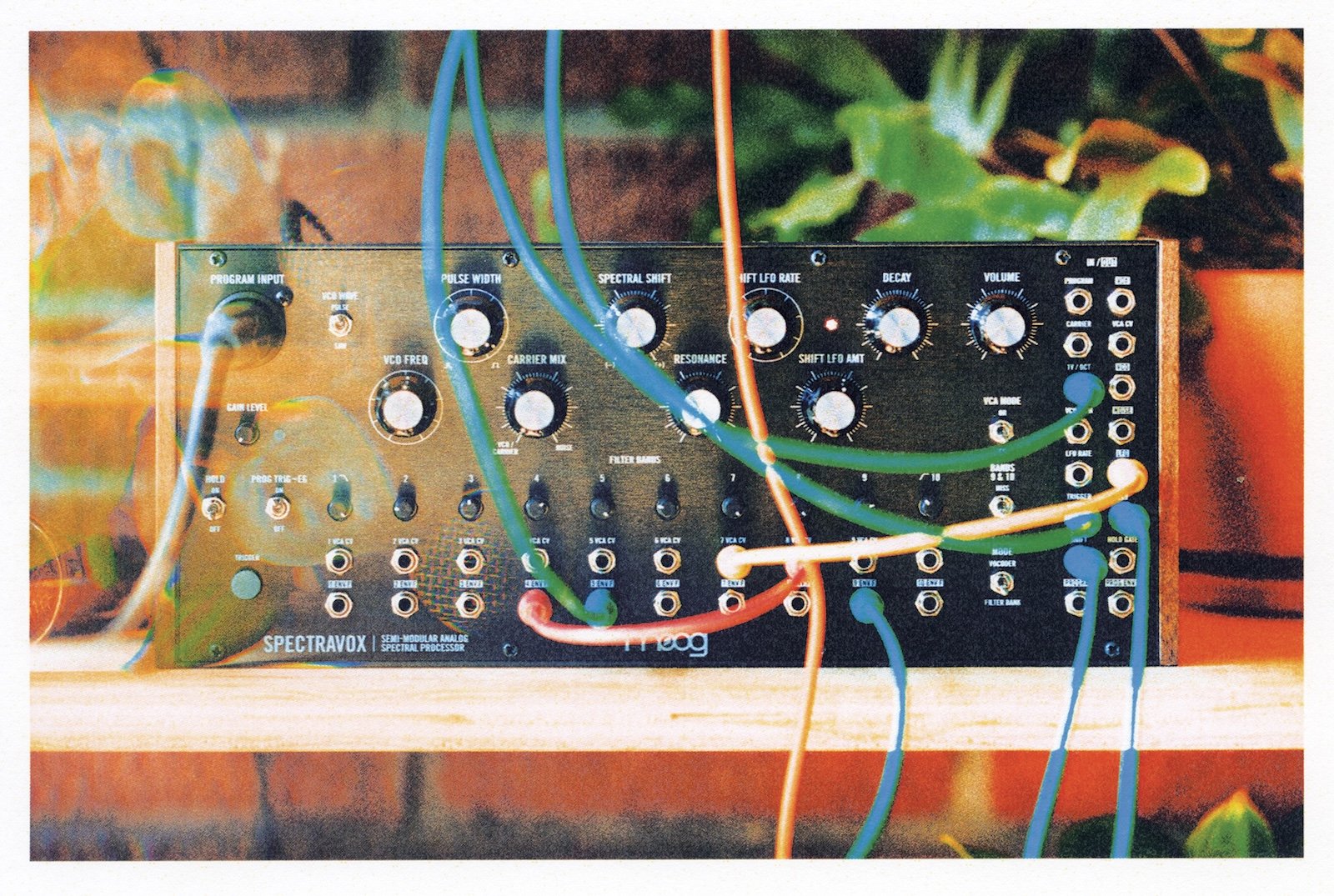
A vocoder is a device designed to impress the spectral characteristics of one sound (the Program signal) onto another signal (the Carrier). The process hinges on the use of two filter banks: an "analysis" bank and a "synthesis" bank. The Program sound passes into the analysis bank; outputs from each individual filter in this bank pass into envelope followers, producing a series of control voltages whose amplitude reflects the loudness of the incoming sound at that specific frequency. The Carrier passes into another filter bank (the "synthesis" bank); the outputs of the synthesis bank's filters pass into a series of VCAs, and then onward to a mixer. By connecting the envelope follower outputs from the analysis bank to the VCA control voltage inputs on the synthesis bank, we create a system by which the spectral characteristics of one sound are mapped onto another. This is the way that the robotic voice sounds commonly associated with vocoders work: a human voice acts as the Program signal, while an oscillator and/or noise source act as the Carrier. This technology was borne out of Homer Dudley's speech synthesis research at Bell Labs; and, ultimately, vocoders have been a critical part of Moog's history (both in Wendy Carlos's work, and in later collaborations with Harald Bode).
Spectravox works in the same way. When set to Vocoder mode, you can plug an external Program signal (any sound you like!) into the patch bay's 3.5mm Program input or the top-left XLR-1/4" combo jack Program input (which features a preamp with plenty of gain). The Program signal passes through an analysis bank, and produces ten envelope follower signals (which may all be individually accessed via the ten "ENV F" jacks on the front panel). The envelope follower signals are automatically connected to the level control inputs for the bands, and may be attenuated using the individual band level controls. Suddenly, you can use your voice, drum machine, or any other signal you like to control the filtering characteristics applied to the Carrier signal. And again, while Spectravox does have an internal oscillator and noise source that you can use as a carrier, remember that you can patch in an external source as well.
The patch bay also provides a direct output for the program signal, as well as a dedicated envelope follower output for the program signal as a whole. By activating the "Prog Trig>EG" switch, you can also use the incoming sound to trigger Spectravox's internal envelope—handy for tightly-timed vocoded sounds. The "Hold" function allows you to momentarily "hold" the state of the Program input's current spectrum, effectively "freezing" that spectral characteristic for application to the carrier sound. This function can be activated using a toggle switch, or the dedicated Hold input on the patch bay.
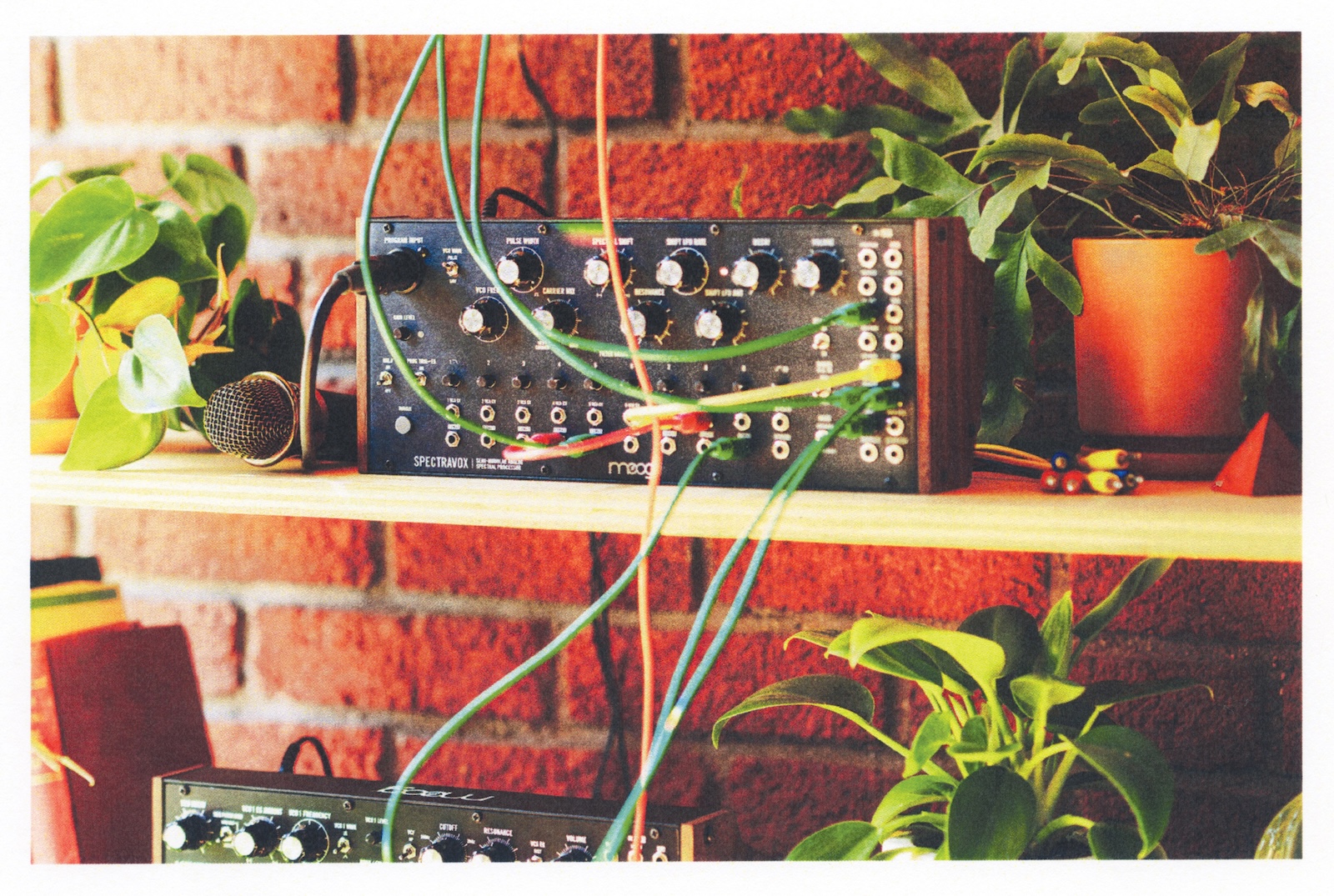
The Bands 9&10 Buzz/Hiss switch also bears explanation. In filter bank mode, this chooses whether the Carrier Mix or the internal noise source is routed to bands 9 & 10 of the synthesis bank. In Vocoder mode, this enables automatic switching between the Carrier Mix and the direct noise source as an audio source for these bands. The general idea is that, when particularly sibilant sound is detected at the Program input, it automatically switches over to use the noise source rather than the oscillator for these bands—assisting in intelligibility when using speech as a program signal. Given that Spectravox has a relatively small number of filter bands, this can go a long way in increasing intelligibility. That said, as with most vocoders, I wouldn't necessarily say that it's easy to understand incoming speech: it's more about the effect than relaying a specific semantic message.
Of course, Spectravox's synthesis bank still offers continuously variable Shift in Vocoder mode—allowing all manner of peculiar spectrum-shifted vocoding effects. Additionally, you can use the per-band envelope follower signals as a modulation source for Spectravox's internal parameters. You could repatch the envelope followers to the filter bands to "scramble" the spectrum—you could use specific bands to modulate the LFO rate, or the oscillator pitch—of, of course, you could use the envelope followers to control external equipment as well. Experiment and no doubt you'll find many peculiar, fun, and inspiring potential uses.
Spectravox: Synthesizer + Spectral Processor Combined
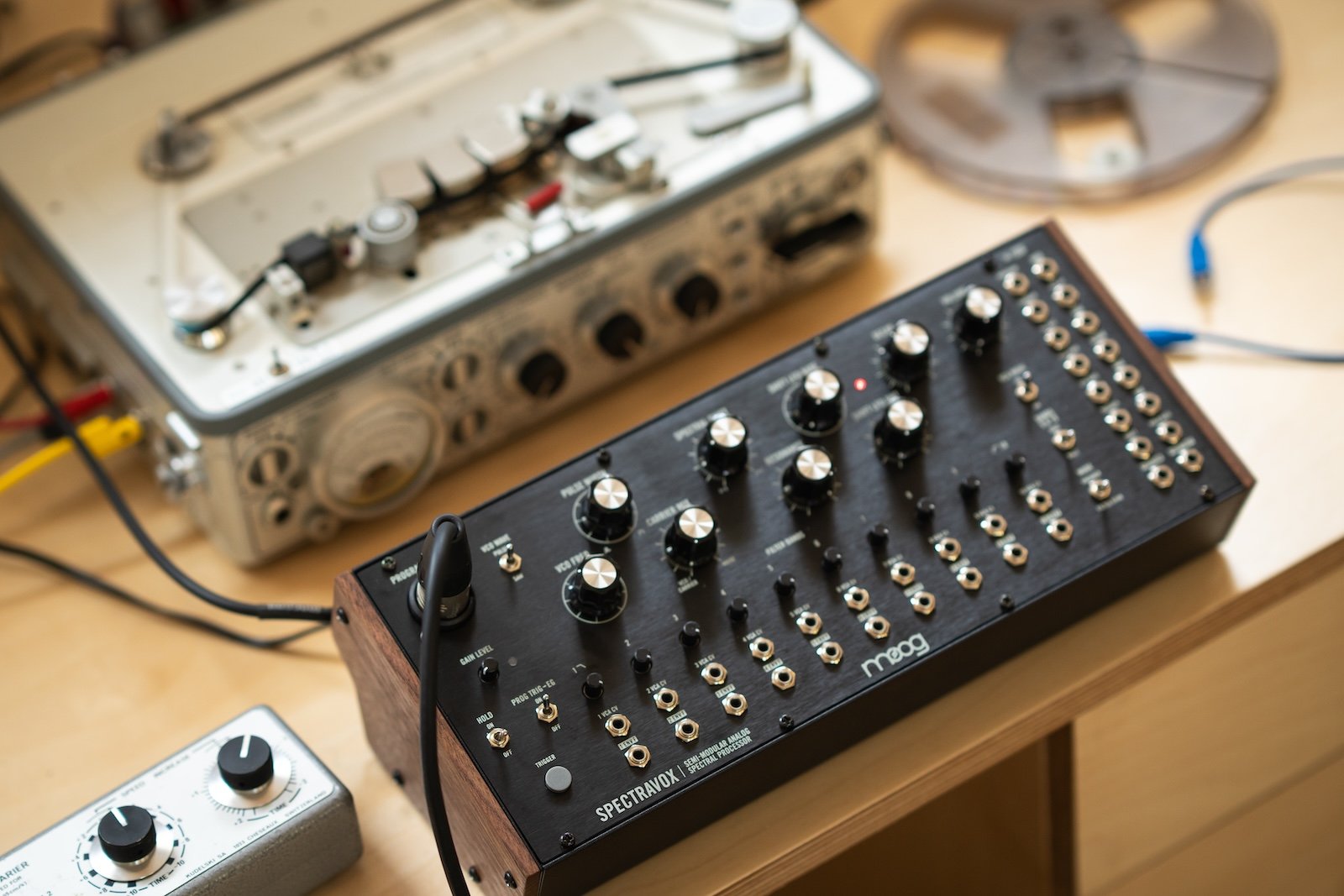
In some senses, Spectravox is the most esoteric of Moog's semi-modular offerings. It doesn't feature any internal sequencing; its sound generation and modulation structure might seem, at first glance, to be fairly bare-bones. However, I'd argue that we shouldn't necessarily look at Spectravox as another synthesizer: while it certainly can be used as one, it truly shines when used as a peculiar processor for its own internal sounds or for external signals.
So, if you're looking for classic Moog sound, you might sooner check out Mother-32, DFAM, Mavis, etc. But if you're looking for a weird resonator—a strange source of odd vocal sounds—a rich playground for filter pinging experimentation—or a means by which to transform even the simplest sounds into an evolving web of intertwined spectral tones and textures...well, it might just be perfect for you.


